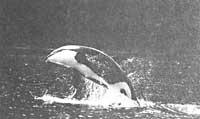Different languages of orcas
John Ford, patron of marine mammals at the Vancouver Public Aquarium, says orcas speak in both “language” and “dialects.” The differences between the different languages can be similar to those between English and Japanese.
Languages are divided into txistus and calls used for submarine communication. Great energy “clicks” like the sound emitted by the orca in its echo navigation are very different from each other.
Although orcas are found in most seas, higher concentrations occur in cold places such as Iceland or Canada.

Ford, in the North Sea of Washington State, has investigated 350 orcas. These orcas are spread over two communities living in very close areas.
The northerly community consists of 16 family groups living from the north of Vancouver Island to Alaska. The southernmost community consists of three groups living from the south of Vancouver Island to Grays Harbour.
Many of the sounds emitted by these animals are at the gates of those who can receive human ears. Therefore, it is possible to record these sounds. A microphone is located on the side of the boat. The received sounds are amplified and then recorded.
Ford, after investigating recorded sounds, claims that each group of orcas normally makes 12 different calls. Ford knows that calls from orcas, whales and dolphins are different. In addition, each group of orcas has discovered that they have their own dialects.
It is also demonstrated that dialects are transmitted from generation to generation. According to Ford “changes occur very slowly and dialects take hundreds of years to develop.” It follows that some dialects can be thousands of years.”
What is known so far is very little, but to what extent do orchestral languages have some complexity?





